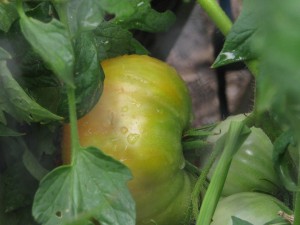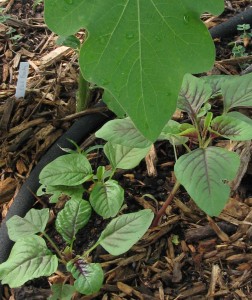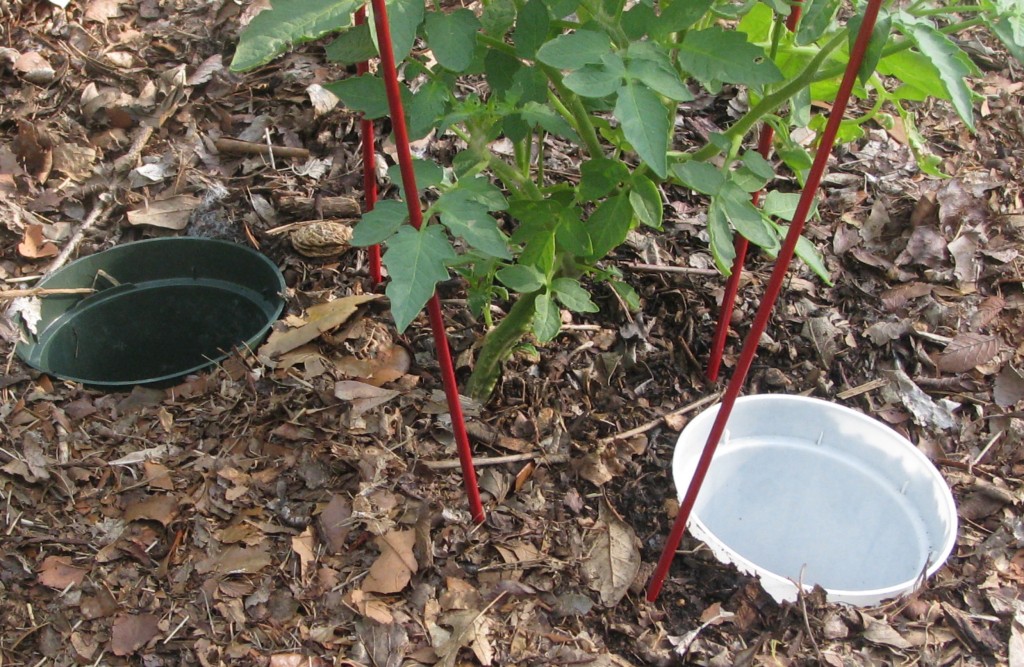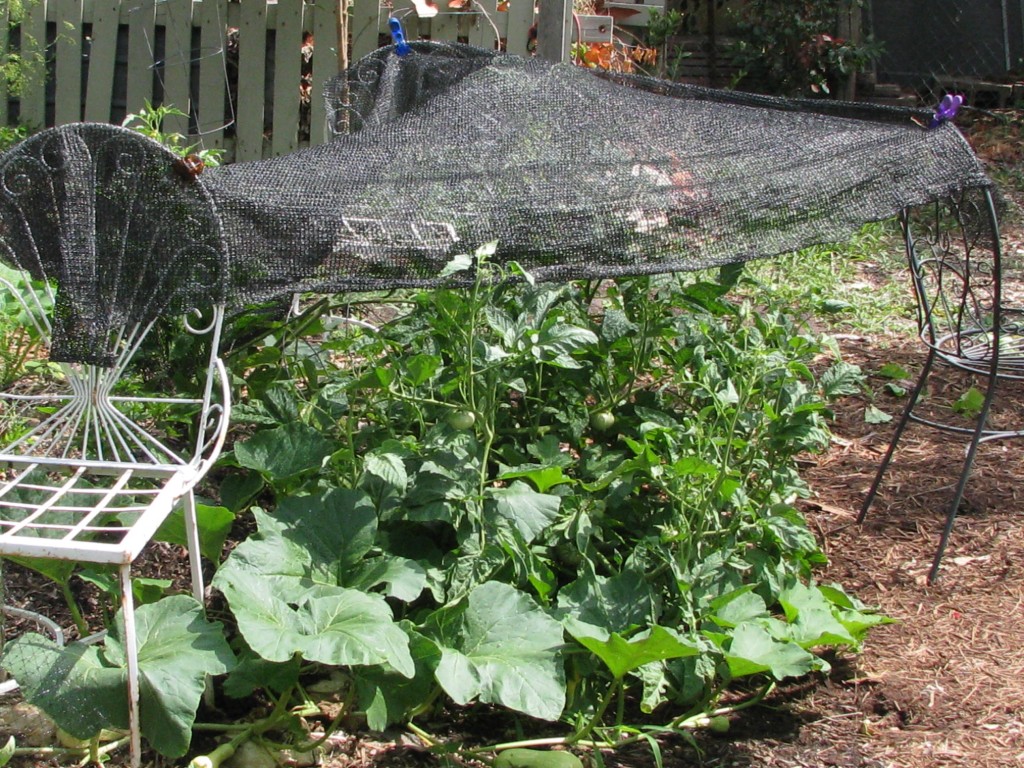A sensible gardener knows better than to try to grow vegetables in extreme heat and extreme drought. Right? Right.
A sensible gardener throws in the shovel and the hoe (and the soaker hoses) when record breaking temperatures make April feel like June and June feel like August. Yes. Definitely.
But what if you’re the kind of gardener who hates to give up the fight until you absolutely have to? The kind who somehow thrives on the hot sweaty challenge of growing vegetables during one of Austin’s hottest, most rain-starved summers ever.
True confession: I’m one of those kind. The harder it gets, the more determined I become. In many matters I consider myself to be quite sensible and pragmatic, but when it comes to gardening, especially growing food, every day is a new day and anything is possible — even rain. So until another rain shower comes along, I get up a little earlier each morning to make time to stand around in the garden holding a water hose on my summer survivors: tomatoes, beans, eggplants and squash.
(Sidenote: Strange but true — I still have several relatively bug free and disease free tomato plants with lots of green tomatoes hanging on them. The photo above is a tomato I plucked from the vine just a few days ago. Check back here for a spring-summer 2011 tomato report — which will include an assessment of my best performing varieties, most successful soil amendments, best tasting fruits, etc, etc.)
Now back to today’s post — the not-so-sensible gardener’s guide to keeping a home vegetable garden limping along even though our state has just been declared a natural disaster area because of relentless extreme drought. It’s also almost time to start a fall garden. Yes, garden friends, late June and July is typically when Austin area gardeners start preparing their beds for a fall garden. Early to mid-July is generally considered a good time to set out tomato plants for a fall harvest.
What follows is a list of things I’ve been doing for the last couple of months to keep a little bit of food coming out of my hot hot garden and onto my dinner table. Feel free to add your own extreme gardening methods to my list (just leave a comment or send me a message (reneesroots@gmail.com). I’m willing to try just about anything (at least once) to keep my heirloom tomatoes going a little longer. And if you’re a rain maker, I really want to hear from you.
1. Mulch mulch and more mulch. Mulch decays faster in high heat, especially with regular watering. So check to make sure you still have a depth of 2-3 inches of chopped leaves, coarse compost, pine needles or whatever you’re using. Spread a thin layer of good compost on top of the soil before topping with mulch to feed microbes and improve water retention. Lately, I’m using a heavier, chunkier pine mulch because it seems to hold moisture a little longer.
2. Dig trenches. Dig a 5-6 inch deep and 3 inch- wide trench around your beds (or even around individual plants) and fill with mix of coarse compost and chopped leaves, or compost and mulch). Best to do this at planting time so you don’t disturb roots. If you’re adding trench after plants are established, start your trench farther away from plants. I’ve known tomato roots to travel as much as a foot through loose garden soil to reach an area of steady moisture.
3. Add shale pieces to your garden soil: Mix a couple of handfuls of shale into each planting hole or dig in 1 or 2 cups per square foot of your growing beds. A UT geologist friend of mine confirmed that shale does indeed hold water, more than vermiculite and much more than decomposed granite. As the soil dries, it draws on additional water stored in the shale pieces. I have several pepper plants that are hanging in there and producing peppers. They only get a few hours of morning sun, and then dappled light in the afternoon. The planting area is loaded with compost, chopped leaves, and several big handfuls of shale. (Note: shale isn’t not cheap, but it doesn’t break down like compost and mulch, so you only have to add it once.)
4. Water at the root zone: Use sunken plastic plant pots, milk jugs or soda bottles to direct water straight to the root zone of each plant. It’s best to install pots and bottles when plant roots are still small so you don’t disturb the roots. If your plant is mature, you can still add a watering pot, but poke around gently in the soil and try to avoid roots. You may need to install pot 5 or 6 inches away from the plant’s stem to avoid damaging roots.
Several vegetable gardeners around town are reporting success this summer with the buried watering pot method, including Iris at Society Garlic and Carla at Austin Urban Gardens. And longtime garden blogger MS at Zanthan Gardens has for several years planted her tomatoes alongside sunken water bottles. My grandmother used to save 1 gallon milk jugs to use as garden water bottles. During really dry spells, she ran a hose from her kitchen sink drain out to her tomato beds, so that every drop of water from the kitchen faucet was doing double duty. (In Austin, direct watering with gray water is not allowed; it must be properly filtered first. By the way, in the near future I plan to take a closer look at the dos and donts of gray water garden watering in this space.)
5. Suspend shade cloth over plants: Create a hoop- or stake-supported shade cloth tent. I’ve found that 40 percent shade cloth works well. It’s available at some local nurseries and online. If you use shade cloth that shades more than 40 percent of the sun, many plants will have difficulty thriving, so the 70 or 80 percent shade cloth commonly sold for shading outdoor patios is not your best choice for vegetable plant shading. In the picture below, I reached for a quick fix with shade cloth to cover one of my sprawling heirloom tomatoes when I saw that some of its leaves were scorched. I know it’s not beautiful, and I could make the setup more aesthetically pleasing, but I’ll save that project for a cooler day.
6. Try lowered instead of raised beds: A well-mulched vegetable bed that’s a few inches below the soil’s surface will hang on to moisture longer than a raised bed. But when a big bad thunderstorm comes along, make sure fast pooling rainwater isn’t trapped in your recessed beds. An overflow trench to take excess water away from the bed is needed during rainy spells (remember when we used to have those?).
7. Hand water: If your vegetable plants are looking thirsty and stressed even though you’re giving them two deep soakings a week using drip irrigation or soaker hoses, you may need to hand-water most mornings to help your plants survive between soaks.
8. Use liquid seaweed and/or Thrive: Heat stressed vegetable plants need extra TLC. Weekly foliar feeding with liquid seaweed solution will help them cope. Monthly drenching with a gallon of water dosed with a few drops of Thrive will also help.
I wonder, is there something like Thrive that works as a tonic for gardeners as we hunker down and wait out the drought? Perhaps I should consult an herbalist. Or maybe a bartender.
Stay cool, and happy gardening!





My money is on you being able to support yourself with your addiction to storytelling and your twin passions of gardening and cooking. How often do addictions support us and not the other way around? You go, girl. Yay, Renee!
Cecilia, thanks for the vote of confidence. Hope I can accomplish half as much as you have with Field and Feast in such a short time.
Let me be the first to congratulate you on the new blog. Very nice and some good advice on veggy gardening. That rain sure did the trick. My eggplant have quadrupled in size over the last week. I think it’s all about water. I cut my tomatoes back to healthy growth and they are doing well too. Hang in there until fall. Let’s hope it will be a fall.
thanks, Jenny. my eggplant enjoyed the rain too, but’s it’s ready for more. I have a couple of tomatoes that have given up the fight and need to be cut back. Thanks for stopping by!
Renee, I am not a gardener, but I did enjoy reading your column at the Statesman and I’m happy to read your writing here, now. Keep up the good work!
Kathryn, thank you. I’m so glad you’re going to be reading.
Congratulations for your first launch! And it’s great!! I’ll change the link on CTG’s blogroll.
Linda, thank you. I still have lots of tweaking to do, and pages to add, but I’m having fun. Thanks for commenting!
Hello, Renee. Long time. Enjoyed the info. My barrel-planted tomatoes (I gravitated to barrels as my vegetable garden space kind of vanished underneath the shade trees a couple of years ago) had a rough go this year, and are on their last gasp already. I’ve used cheese clothe previous years to cut down on the leaf burn but was too lazy this year and suffered from it. I just can’t tolerate the tasteless grocery tomatoes, and am trying to get every last tomato off the vines before they give up the ghost. Have you done much barrel planting? If so, any lessons?
I hope you are well. Missed you at the Shorthorn reunion. I enjoyed seeing Hinshaw, Collier, Sanderson, and Darrell Dunn, as well as Dot and John.
All the best,
John
Hey John. Great to hear from you. I’m not fond of big reunion events but would love to have mini-reunion with you guys sometime. I’ve got a couple of tomatoes growing in metal tubs and one in a half wine barrel. For me the key to successful container tomatoes is remembering to feed more often (I alternate dry organic fertilizers with top dressing of compost), mixing in plenty of moisture retaining materials (leaf mould, compost, shale), and not allowing pots to dry out completely. Take care and stay in touch. I’ll look for you on FB.
Congratulations on the new blog, it looks good already.
You need to come to one of our blogger get togethers. Would love to meet you, Bob
Thanks, Bob. I would like to meet you too. I plan to start attending more blogger get-togethers now that my schedule is lighter.
Agreed. Great blog.
Thanks, Dianne.
Way to go, Renee! Look forward to more of your tips and insights, and (of course) your recipes.
The site will grow and bear fruit, just you wait and see!
Congratulations dear.
Mark, hope it bears fruit like your amazing grapefruit tree! Thanks for visiting.
Fabulous that you’re continuing your blog. Austin gardeners depend on your gardening tips and love your recipes!
Thanks for stopping by, Kim. I’ll get back with you soon about your composter. I’d like to hear more about it.
Renee, thanks for putting up the new Gardening Blog outside of the Statesman! I’m a Pumpkin grower out of Bastrop and I currently work the Advertising side of the Statesman to pay the bills barely. Ha ha ha. Hope you like your new gig. ~ Big Z
Hello Big Z. Thanks for coming to visit my new blog. I’d like to hear more about your pumpkins. Do you grow them to sell at market or just for home consumption?
I never used to care about whether things were homegrown or storebought until I had Renee’s tomatoes (and all the other samples from her wonderful garden).
-Annie <3
Annie, thanks so much. That means a lot to me. When you were 10, it was obvious you had a sophisticated sense of taste, especially for one so young. You’re always welcome in my garden and in my kitchen.
It looks so great! And as always, perfectly written in your own voice. I can’t wait for more.
Thank you, Diane. I’m so glad you stopped by.
Hi Renee,
This is such a great and informative site! I have bookmarked it.
Thanks,
Jeff (FITD)
Hey, FITD. Good to hear from you. I’m putting together a post on this summer’s tomatoes. I know you’re a beefsteak fan, so thought you’d like to know that an older variety of beefsteak is looking like the big winner in my garden. Huge healthy plant. Have harvested almost two dozen big beautiful tasty fruits, with more plump green guys still on the vine. Course it probably helps that the plant is growing out of soil that’s about 80 percent homemade compost.
Love reading your gardening advice. Congrats on your new status as a footloose and fancy free blogger!
Hello, Crispin. Welcome to my new blog. I’ll try to keep it useful and interesting so you’ll want to come back and visit often. Let me know if you have particular concerns in your garden that you’d like for me to address at some point.
Looks great so far, Renee!
Thanks, Marc. And thanks for stopping by.
Hi Renee,
The website looks great. I just planted fall tomatoes so I am already using some of the advice from your blog on gardening in the HEAT! I’ve succeeded in the past using shade cloth and deep mulch but I think this year will be the biggest challenge ever because it looks like we are going to set heat and drought records in the next two months. Pray for rain!!!
Larry
Larry, you were sure right about this record breaking summer. I feel grateful for any little edible thing I’ve gotten out this summer’s garden.
Hi Renee!
Have you had any luck with cucumbers? Last year we had so many that we put up jars and jars of pickles and this year in HoHi we’ve had about 4. total.
Thanks!
No luck here with cucumbers. I didn’t protect well enough from squash vine borers so plants were goners early on. I think the extreme heat has made it harder for a lot of veg to set fruit. If your plants are still healthy, you might get more when temps stay below 100.